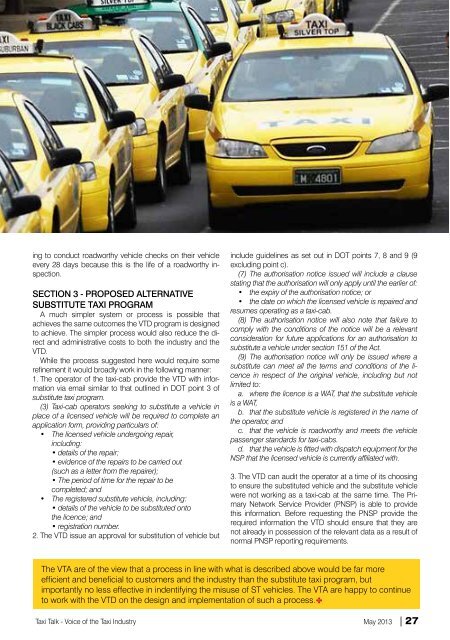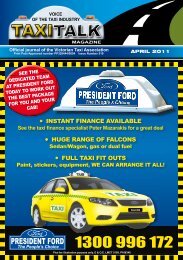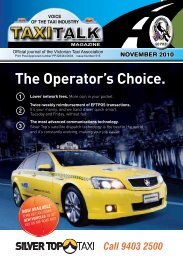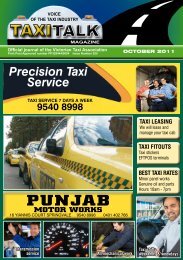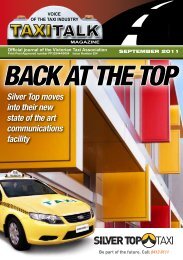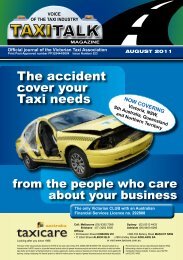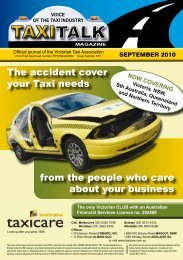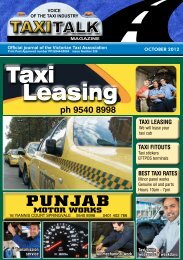May 2013 - Taxi Talk Magazine
May 2013 - Taxi Talk Magazine
May 2013 - Taxi Talk Magazine
Create successful ePaper yourself
Turn your PDF publications into a flip-book with our unique Google optimized e-Paper software.
ing to conduct roadworthy vehicle checks on their vehicle<br />
every 28 days because this is the life of a roadworthy inspection.<br />
SECTION 3 - PROPOSED ALTERNATIVE<br />
SUBSTITUTE TAXI PROGRAM<br />
A much simpler system or process is possible that<br />
achieves the same outcomes the VTD program is designed<br />
to achieve. The simpler process would also reduce the direct<br />
and administrative costs to both the industry and the<br />
VTD.<br />
While the process suggested here would require some<br />
refinement it would broadly work in the following manner:<br />
1. The operator of the taxi-cab provide the VTD with information<br />
via email similar to that outlined in DOT point 3 of<br />
substitute taxi program.<br />
(3) <strong>Taxi</strong>-cab operators seeking to substitute a vehicle in<br />
place of a licensed vehicle will be required to complete an<br />
application form, providing particulars of:<br />
• The licensed vehicle undergoing repair,<br />
including:<br />
• details of the repair;<br />
• evidence of the repairs to be carried out<br />
(such as a letter from the repairer);<br />
• The period of time for the repair to be<br />
completed; and<br />
• The registered substitute vehicle, including:<br />
• details of the vehicle to be substituted onto<br />
the licence; and<br />
• registration number.<br />
2. The VTD issue an approval for substitution of vehicle but<br />
include guidelines as set out in DOT points 7, 8 and 9 (9<br />
excluding point c).<br />
(7) The authorisation notice issued will include a clause<br />
stating that the authorisation will only apply until the earlier of:<br />
• the expiry of the authorisation notice; or<br />
• the date on which the licensed vehicle is repaired and<br />
resumes operating as a taxi-cab.<br />
(8) The authorisation notice will also note that failure to<br />
comply with the conditions of the notice will be a relevant<br />
consideration for future applications for an authorisation to<br />
substitute a vehicle under section 151 of the Act.<br />
(9) The authorisation notice will only be issued where a<br />
substitute can meet all the terms and conditions of the licence<br />
in respect of the original vehicle, including but not<br />
limited to:<br />
a. where the licence is a WAT, that the substitute vehicle<br />
is a WAT,<br />
b. that the substitute vehicle is registered in the name of<br />
the operator, and<br />
c. that the vehicle is roadworthy and meets the vehicle<br />
passenger standards for taxi-cabs.<br />
d. that the vehicle is fitted with dispatch equipment for the<br />
NSP that the licensed vehicle is currently affiliated with.<br />
3. The VTD can audit the operator at a time of its choosing<br />
to ensure the substituted vehicle and the substitute vehicle<br />
were not working as a taxi-cab at the same time. The Primary<br />
Network Service Provider (PNSP) is able to provide<br />
this information. Before requesting the PNSP provide the<br />
required information the VTD should ensure that they are<br />
not already in possession of the relevant data as a result of<br />
normal PNSP reporting requirements.<br />
The VTA are of the view that a process in line with what is described above would be far more<br />
efficient and beneficial to customers and the industry than the substitute taxi program, but<br />
importantly no less effective in indentifying the misuse of ST vehicles. The VTA are happy to continue<br />
to work with the VTD on the design and implementation of such a process.D<br />
<strong>Taxi</strong> <strong>Talk</strong> - Voice of the <strong>Taxi</strong> Industry <strong>May</strong> <strong>2013</strong> | 27


